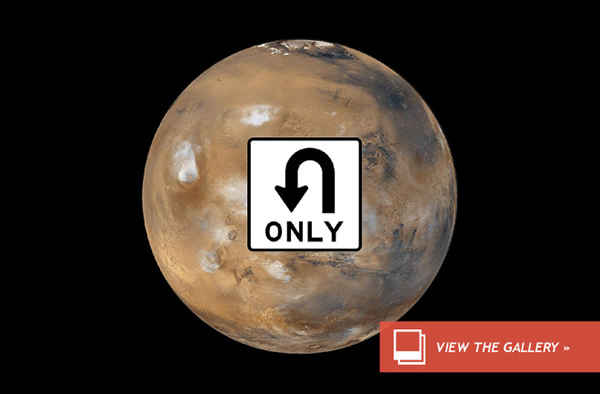NASA's 'Inspirational' Mars Flyby
NASA's 'Inspirational' Mars Flyby
Planetary flybys are awesome.
As a spacecraft swings around the trailing side of a planet it gains speed and direction, momentum engineers can use to accelerate it to its next destination using little if any fuel for mid-course corrections. It’s not a new idea. Gravity assists are how the Voyager probes visited the outer planets with one launch, it’s how NASA got Apollo 13 home and it’s how Denis Tito plans to whip a married couple around the far side of Mars within the decade.
And in the mid 1960s, it’s something NASA considered as a future application for its Apollo hardware.
NASA’s study of manned flybys came via Bellcomm, a division of AT&T established in 1963 to assist the space agency with research, development, and overall documentation of systems integration. In the mid 1960s, flybys with upgraded and modified Apollo hardware seemed like a natural stepping stone between the Apollo lunar missions and the agency’s inevitable next steps of an Earth-orbiting space station, manned Mars landings, and manned missions in orbit around Venus.
It was Bellcomm mathematician A. A. VanderVeen who studied the manned flyby possibilities for NASA.
In 1967, he identified 5 favorable launch opportunities for a Mars flyby between 1978 and 1986. Two windows in 1979 and 1983 were ideal, feasible with then-existing launch technology and had the shortest transit time between planets. VanderVeen found that very little propulsion was needed with these launch windows.
After the initial burn towards Mars, physics would take over and guide the spacecraft to its rendezvous with Mars. Probes would do the hard work. Approaching Mars, the crew would release automated probes, one of which could even land on the surface, collect a sample, and launch to rendezvous with the spacecraft on its way back to Earth. VanderVeen also noted that these dates were perfect: Mars was bound to be NASA’s next target after Apollo.
But weight was a persistent issue in all the Mars flyby scenarios; the propulsion needed to launch a spacecraft into Earth orbit then fire it off to Mars was substantial. VanderVeen found an elegant, and scientifically exciting, solution: add a Venus flyby to the Mars trip. Mars, Earth, and Venus align with the sun five times every 32 years, but Venus and Mars alignments happen more frequently making double (Earth-Venus-Mars-Earth) or even triple (Earth-Venus-Mars-Venus-Earth) flybys a viable mission. Taking advantage of favorable launch windows to Venus also reduced overall launch weight.
VanderVeen found triple flyby opportunities in February 1977, as well as in 1981 and 1983. He described the 1981 mission in detail in a report from September 1967. The 790 day mission would begin, ideally, with a launch on May 26, 1981. It would swing by Venus on Dec. 28, past Mars on Oct. 5, 1982, past Venus again on March 1, 1983 before splashing down on Earth on July 25.
VanderVeen kept looking for possible flyby windows, and the more he looked the more he found them. He found a chance in 1978 for a dual-planet flyby, an Earth-Venus-Mars-Earth mission that had the option of adding a second pass by Venus on the return leg from Mars. This mission would ideally launch on Nov. 28, 1978, the crew would pass Venus on May 11, 1979, Mars on Nov. 25, Venus again on Jan. 29, 1980 and return to Earth on Jan. 31, 1981. It would be an 800 day mission.
With every launch opportunity, VanderVeen highlighted the unique scientific aspect of each mission. By virtue of the planets’ continual motion around their own axis and orbits around the sun, each flyby window presented the potential crew with a different view of the planet. In windows would have the crew fly over a planet’s pole, others around the equator. Some missions would take the crew around the night side of the planet, others would have then swing around the day side. But, scientifically speaking, there were no bad paths. Whatever the crew couldn’t see and record visually they could measure with infrared sensors and mapping radars.
These flybys never really stood a chance at flying. Not only were they predominantly proof of concept mission studies designed to show what Apollo hardware was capable of, NASA’s future was too uncertain to really plan something so lofty at the time.
Maybe the time is right now. Maybe Dennis Tito’s team will discover some awesome multi-planet flyby opportunity as a backup in case Inspiration Mars misses its January 2018 launch date.
Mar 4, 2013 11:29 AM ET by Amy Shira Teitel












